During spring break, a group of 11 MMFS students and 7 faculty and staff members traveled to South Africa. This powerful experience prompted the group to reflect on the progress made since apartheid and the ongoing challenges Black South Africans continue to face. It forced them to consider the lasting impact of systemic inequality and the work still needed to achieve true justice and equity—in South Africa, around the world, and back home in Brooklyn.
Below is a wrap-up of their journey. You can also enjoy this curated album of US Director Mark Doty’s photographs.
Johannesburg
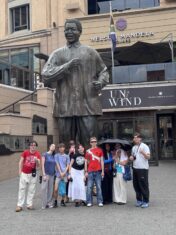 Our trip began in Johannesburg with our tour guide giving us a brief history of apartheid in South Africa—colonization, the creation of an apartheid state, and the ways people risked or lost their lives to eliminate the apartheid regime. Our first stop was Soweto Township, where, in 1976, a student-led protest against being forced to receive education in Afrikaans, the language of the oppressor, resulted in a widespread revolt that turned into an uprising against the government. We visited Regina Mundi Roman Catholic Church where students sought refuge during the violent police retaliation of the Soweto Uprising. We also toured the Hector Pieterson Museum, named after the 13-year-old boy who was the first victim of the Soweto Uprising.
Our trip began in Johannesburg with our tour guide giving us a brief history of apartheid in South Africa—colonization, the creation of an apartheid state, and the ways people risked or lost their lives to eliminate the apartheid regime. Our first stop was Soweto Township, where, in 1976, a student-led protest against being forced to receive education in Afrikaans, the language of the oppressor, resulted in a widespread revolt that turned into an uprising against the government. We visited Regina Mundi Roman Catholic Church where students sought refuge during the violent police retaliation of the Soweto Uprising. We also toured the Hector Pieterson Museum, named after the 13-year-old boy who was the first victim of the Soweto Uprising.
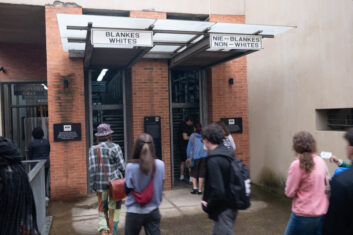 We also toured the Soweto home of Nelson and Winnie Mandela (which was on the same street Desmond Tutu lived on). Our next stop was the Apartheid Museum, where we were joined by MMFS English teacher Kira Schlesinger who was visiting her family in South Africa. Visitors to the Apartheid Museum receive entry tickets, randomly marked White or Non-White. “Non-White” ticket holders had to enter a smaller exhibit and to take the stairs. We explored a deep dive into the life, activism, imprisonment and presidency of Nelson Mandela, as well as an exhibit on the rise and fall of apartheid in South Africa.
We also toured the Soweto home of Nelson and Winnie Mandela (which was on the same street Desmond Tutu lived on). Our next stop was the Apartheid Museum, where we were joined by MMFS English teacher Kira Schlesinger who was visiting her family in South Africa. Visitors to the Apartheid Museum receive entry tickets, randomly marked White or Non-White. “Non-White” ticket holders had to enter a smaller exhibit and to take the stairs. We explored a deep dive into the life, activism, imprisonment and presidency of Nelson Mandela, as well as an exhibit on the rise and fall of apartheid in South Africa.
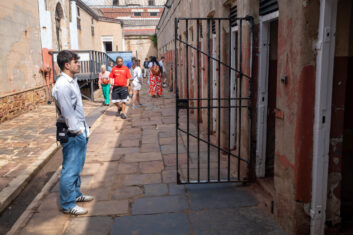 The next day we visited Constitution Hill. Our tour started with Old Fort Prison, which housed criminal and political prisoners including Nelson Mandela and Mahatma Gandhi. We learned that prisoners were treated differently depending on their race. The humiliation and torture these prisoners endured, along with the filthy, disease ridden living conditions, were unfathomable. After the fall of apartheid, the new South African government built their highest court, the Constitutional Court, on the site of this prison. We also visited the house where Nelson Mandela lived after his release from prison and during his presidency.
The next day we visited Constitution Hill. Our tour started with Old Fort Prison, which housed criminal and political prisoners including Nelson Mandela and Mahatma Gandhi. We learned that prisoners were treated differently depending on their race. The humiliation and torture these prisoners endured, along with the filthy, disease ridden living conditions, were unfathomable. After the fall of apartheid, the new South African government built their highest court, the Constitutional Court, on the site of this prison. We also visited the house where Nelson Mandela lived after his release from prison and during his presidency.
Our next stop was the Cradle of Humankind, one of the richest fossil sites in the world, where some of the earliest evidence of human life was found. We took a boat ride through a series of themed caves that represented the journey through time and the evolution of life on Earth.
Back at the hotel at the end of the day, some students worked on their daily reflections, while others gathered around Amin’s computer to watch the beginning of March Madness.
Kruger National Park
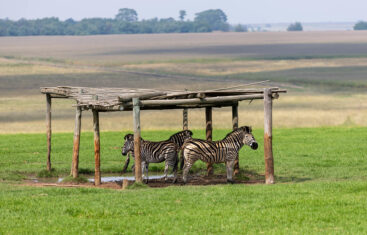 For our next adventure, we took a scenic six-hour journey toward Kruger National Park, making several memorable stops along the way. We had our first wildlife encounter before we even left the highway. Right behind a KFC drive-thru, we spotted zebras, impalas, ostriches, and even a rhino family! The excitement of seeing these incredible animals so early in our trip set the tone for an unforgettable day.
For our next adventure, we took a scenic six-hour journey toward Kruger National Park, making several memorable stops along the way. We had our first wildlife encounter before we even left the highway. Right behind a KFC drive-thru, we spotted zebras, impalas, ostriches, and even a rhino family! The excitement of seeing these incredible animals so early in our trip set the tone for an unforgettable day.
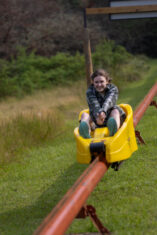 One of our most thrilling stops was Long Tom Misty Mountain, a breathtaking highland retreat known for its panoramic views and rich history. Here, students and adults experienced the thrill of a 1.7 km toboggan car ride, racing down the mountainside through the grasslands and forest in just under three minutes. The real fun, however, was watching everyone attempt to stop at the end—some with precision; others…not so much!
One of our most thrilling stops was Long Tom Misty Mountain, a breathtaking highland retreat known for its panoramic views and rich history. Here, students and adults experienced the thrill of a 1.7 km toboggan car ride, racing down the mountainside through the grasslands and forest in just under three minutes. The real fun, however, was watching everyone attempt to stop at the end—some with precision; others…not so much!
We continued to Graskop Gorge, a lush, dramatic canyon, with stunning waterfalls and a rich ecosystem of indigenous plants and wildlife. At the base of the gorge, we stepped out into a rainforest-like paradise.
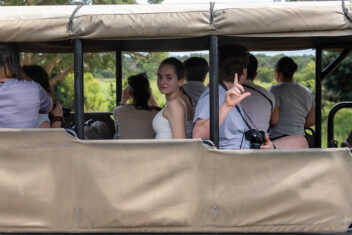 The next day was our big safari day—a full day game drive in Kruger National Park, which is the size of New Jersey and home to 336 tree species, 49 fish, 34 amphibians, 114 reptiles, 507 birds, and 147 mammals. It was founded in 1898 by then president Paul Kruger to protect wildlife from excessive hunting. Although this park was established before the formal apartheid government, there were racial segregation laws that removed Black South Africans from this land and overlooked the work Black South African conservationists were doing to protect the various species. So there have been calls to rename this park to reflect South Africa’s diverse history.
The next day was our big safari day—a full day game drive in Kruger National Park, which is the size of New Jersey and home to 336 tree species, 49 fish, 34 amphibians, 114 reptiles, 507 birds, and 147 mammals. It was founded in 1898 by then president Paul Kruger to protect wildlife from excessive hunting. Although this park was established before the formal apartheid government, there were racial segregation laws that removed Black South Africans from this land and overlooked the work Black South African conservationists were doing to protect the various species. So there have been calls to rename this park to reflect South Africa’s diverse history.
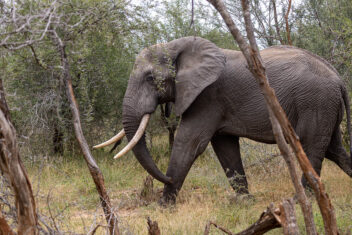 There were so many moments of awe during this safari. We were overwhelmed by the proximity, size, and beauty of the animals we encountered. After beginning our journey with hyenas—who popped up again later in true Lion King fashion—we also saw zebras. When seen in herds, it is almost impossible to distinguish individual zebras from the large mass of black and white stripes.
There were so many moments of awe during this safari. We were overwhelmed by the proximity, size, and beauty of the animals we encountered. After beginning our journey with hyenas—who popped up again later in true Lion King fashion—we also saw zebras. When seen in herds, it is almost impossible to distinguish individual zebras from the large mass of black and white stripes.
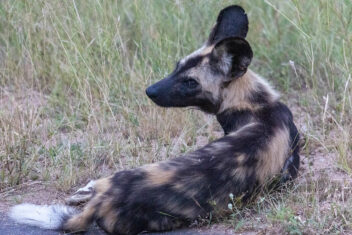 We were also really lucky to see African Wild Dogs. There are only 300 in the entire park and we saw 8 of them! And then came the elephants and giraffes. The size, grace, and movement of these animals was jaw dropping. This was one of those moments when we were unable to hold back the gasps. We also saw cape bushbacks, wildebeests, impalas, kudus galore, a warthog, and a hippopotamus. The last three highlights were a couple of leopards, lion, and water buffalo—rare sightings, apparently! What an unforgettable experience.
We were also really lucky to see African Wild Dogs. There are only 300 in the entire park and we saw 8 of them! And then came the elephants and giraffes. The size, grace, and movement of these animals was jaw dropping. This was one of those moments when we were unable to hold back the gasps. We also saw cape bushbacks, wildebeests, impalas, kudus galore, a warthog, and a hippopotamus. The last three highlights were a couple of leopards, lion, and water buffalo—rare sightings, apparently! What an unforgettable experience.
After a full day of safari and a good night’s sleep, we boarded the bus for a six-hour drive back to Johannesburg and our flight to Cape Town.
Cape Town
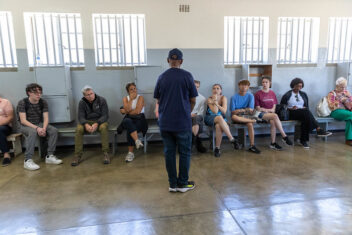 The day began with a ferry ride to Robben Island, which holds deep historical significance to South Africa’s fight against apartheid. We saw the tiny cell where Nelson Mandel spent 18 of his 27 years in prison. We saw the Limestone Quarry where prisoners labored, their eyesight permanently damaged by the glare of the white limestone. Our guide, Mxolisi, had himself been imprisoned for 12 years at Robben Island for his role in the Defiance Campaign. His crime? Refusing to carry his passbook. (During apartheid, all Black South Africans were forced to carry a passbook that dictated where they could live, work, and travel.) Mxolisi’s firsthand account brought into sharp focus the daily humiliation and oppression Black South Africans endured under apartheid and even worse on the island.
The day began with a ferry ride to Robben Island, which holds deep historical significance to South Africa’s fight against apartheid. We saw the tiny cell where Nelson Mandel spent 18 of his 27 years in prison. We saw the Limestone Quarry where prisoners labored, their eyesight permanently damaged by the glare of the white limestone. Our guide, Mxolisi, had himself been imprisoned for 12 years at Robben Island for his role in the Defiance Campaign. His crime? Refusing to carry his passbook. (During apartheid, all Black South Africans were forced to carry a passbook that dictated where they could live, work, and travel.) Mxolisi’s firsthand account brought into sharp focus the daily humiliation and oppression Black South Africans endured under apartheid and even worse on the island.
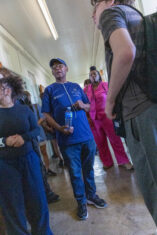 While we heard stories of the prisoners’ suffering, we also learned about their unbreakable spirit. Even in the harshest conditions, a small gesture—like a smile, a word of encouragement, or a touch on the shoulder—could change a prisoner’s entire day. Our bus tour guide spoke of the “Each One Teach One” philosophy among the prisoners, in which those who were more educated would secretly teach others how to read and write and understand the law. They found ways to empower one another, proving that knowledge and solidarity could never be confined by prison walls.
While we heard stories of the prisoners’ suffering, we also learned about their unbreakable spirit. Even in the harshest conditions, a small gesture—like a smile, a word of encouragement, or a touch on the shoulder—could change a prisoner’s entire day. Our bus tour guide spoke of the “Each One Teach One” philosophy among the prisoners, in which those who were more educated would secretly teach others how to read and write and understand the law. They found ways to empower one another, proving that knowledge and solidarity could never be confined by prison walls.
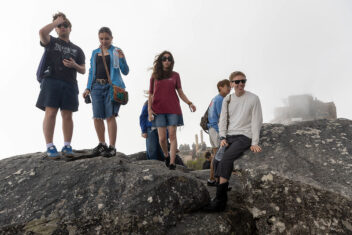 Next we visited one of the New 7 Wonders of Nature—Table Mountain, rising 3,558 feet above sea level. One of the oldest mountains in the world, it is estimated to be over 260 million years old, and is home to more than 1,470 plant species! We ascended via a cable car that rotated 360 degrees, offering breathtaking panoramic views of the city, ocean, and surrounding landscape. At the top, we felt like we were in heaven floating above the clouds.
Next we visited one of the New 7 Wonders of Nature—Table Mountain, rising 3,558 feet above sea level. One of the oldest mountains in the world, it is estimated to be over 260 million years old, and is home to more than 1,470 plant species! We ascended via a cable car that rotated 360 degrees, offering breathtaking panoramic views of the city, ocean, and surrounding landscape. At the top, we felt like we were in heaven floating above the clouds.
This day was a powerful mix of reflection and appreciation. We walked through history, learned lessons of resilience, and stood in awe of nature’s beauty.
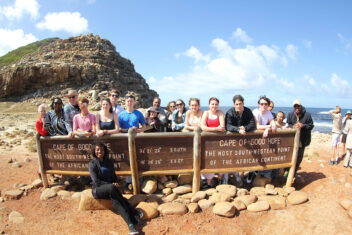 The next day we stopped for a photo op at the Cape of Good Hope, the southwestern most point of the African continent, and an important landmark in nautical history. It was first rounded by Portuguese explorer Bartolomeu Dias in 1488 and originally named the “Cape of Storms” due to its treacherous waters. It was later renamed to reflect the hope of establishing a sea route to India. Over the centuries, it has played a significant role in global maritime trade, as well as colonial expansion.
The next day we stopped for a photo op at the Cape of Good Hope, the southwestern most point of the African continent, and an important landmark in nautical history. It was first rounded by Portuguese explorer Bartolomeu Dias in 1488 and originally named the “Cape of Storms” due to its treacherous waters. It was later renamed to reflect the hope of establishing a sea route to India. Over the centuries, it has played a significant role in global maritime trade, as well as colonial expansion.
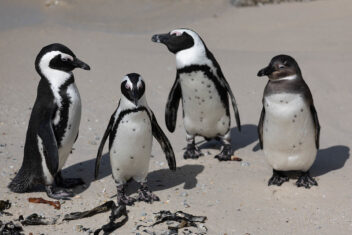 After lunch, we walked down to Boulder Beach to see a colony of African penguins, critically endangered due to the impacts of commercial fishing and climate change. Our final stop of the day was Kirstenbosch Botanical Garden, the first botanical garden in the world to focus on indigenous plant conservation. While walking around the gardens, we heard the sound check for an upcoming Goo Goo Dolls concert.
After lunch, we walked down to Boulder Beach to see a colony of African penguins, critically endangered due to the impacts of commercial fishing and climate change. Our final stop of the day was Kirstenbosch Botanical Garden, the first botanical garden in the world to focus on indigenous plant conservation. While walking around the gardens, we heard the sound check for an upcoming Goo Goo Dolls concert.
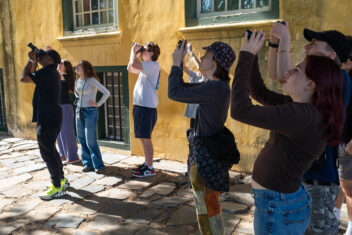 On our last day in South Africa, before heading to the airport, we visited the District Six Museum, which commemorates 60,000 people who were forcibly removed from their neighborhood during apartheid. We also saw the Castle of Good Hope, an old fort turned museum. Finally, we took a guided tour of the Langa Township, where we engaged with residents to gain a deeper understanding of daily life in one of South Africa’s oldest Black townships.
On our last day in South Africa, before heading to the airport, we visited the District Six Museum, which commemorates 60,000 people who were forcibly removed from their neighborhood during apartheid. We also saw the Castle of Good Hope, an old fort turned museum. Finally, we took a guided tour of the Langa Township, where we engaged with residents to gain a deeper understanding of daily life in one of South Africa’s oldest Black townships.
This trip to South Africa was not just about sightseeing but about understanding the past, questioning the present, and shaping the future.